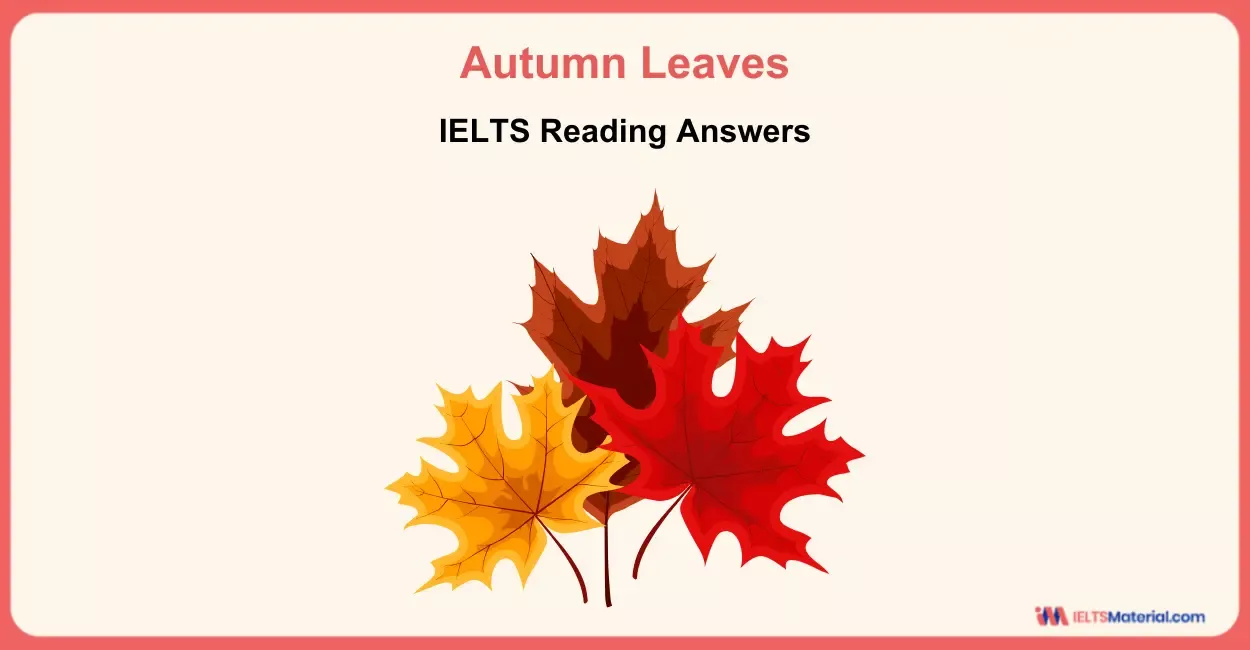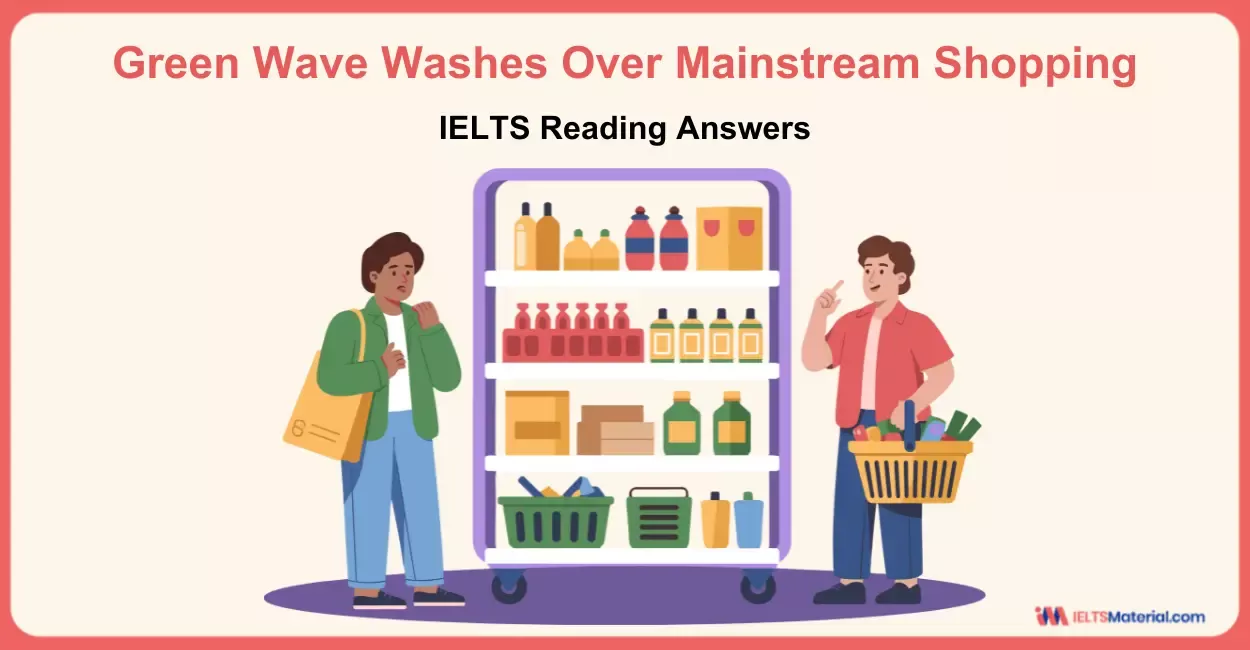Hunting Perfume in Madagascar – IELTS Reading Answers
12 min read
Updated On
-
Copy link
Get familiar with band 8+ tips to attempt the IELTS Reading passage on ‘Hunting Perfume in Madagascar’. Learn strategies for Matching Information, True/False/Not Given, and Diagram Completion questions while diving into the answers with explanations.
Table of Contents

Limited-Time Offer : Access a FREE 10-Day IELTS Study Plan!
A Ever since the unguentari plied their trade in ancient Rome, perfumers have to keep abreast of changing fashions. These days they have several thousand ingredients to choose from when creating new scents, but there is always demand for new combinations. The bigger the palette of smells, the better the perfumer’s chance of creating something fresh and appealing. Even with everyday products such as shampoo and soap, kitchen cleaners and washing powders, consumers are becoming increasingly fussy. And many of today’s fragrances have to survive tougher treatment than ever before, resisting the destructive power of bleach or a high temperature wash cycle. Chemists can create new smells from synthetic molecules, and a growing number of the odours on the perfumer’s palette are artificial. But nature has been in the business far longer.
B The island of Madagascar is an evolutionary hot spot; 85% of its plants are unique, making it an ideal source for novel fragrances. Last October, Quest International, a company that develops fragrances for everything from the most delicate perfumes to cleaning products, sent an expedition to Madagascar in pursuit of some of nature’s most novel fragrances. With some simple technology, borrowed from the pollution monitoring industry, and a fair amount of ingenuity, the perfume hunters bagged 20 promising new aromas in the Madagascan rainforest. Each day the team set out from their “hotel”—a wooden hut lit by kerosene lamps, and trailed up and down paths and animal tracks, exploring the thick vegetation up to 10 meters on either side of the trail. Some smells came from obvious places, often big showy flowers within easy reach- Others were harder to pin down. “Often it was the very small flowers that were much more interesting, says Clery. After the luxuriance of the rainforest, the little-known island of Nosy Hara was a stark, dry place geologically and biologically very different from the mainland, “Apart from two beaches, the rest of the Island Is impenetrable, except by hacking through the bush, says Clery. One of the biggest prizes here was a sweet- smelling sap weeping from the gnarled branches of some ancient shrubby trees in the parched Interior. So far no one has been able to identify the plant.
C With most flowers or fruits, the hunters used a technique originally designed to trap and identify air pollutants. The technique itself is relatively simple. A glass bell jar or flask is fitted over the flower. The fragrance molecules are trapped in this “headspace” and can be extracted by pumping the air out over a series of filters which absorb different types of volatile molecules. Back home in the laboratory, the molecules are flushed out of the filters and injected into a gas chromatograph for analysis. If it is impossible to attach the headspace gear, hunters fix an absorbent probe close to the source of the smell. The probe looks something like a hypodermic syringe, except that the ‘needle’ is made of silicone rubber which soaks up molecules from the air. After a few hours, the hunters retract the rubber needle and seal the tube, keeping the odour molecules inside until they can.be injected into the gas chromatograph in the laboratory.
D Some of the most promising fragrances were those given off by resins that oozed from the bark of trees. Resins are the source of many traditional perfumes, including frankincense and myrrh. The most exciting resin came from a Calophyllum tree, which produces a strongly scented medicinal oil. The sap of this Calophyllum smelt rich and aromatic, a little like church incense. But it also smelt of something the fragrance industry has learnt to live without – castoreum, a substance extracted from the musk glands of beavers and once a key ingredient in many perfumes. The company does not use animal products any longer, but it was wonderful to find a tree with an animal smell.
E The group also set out from the island to capture the smell of coral reefs. Odors that conjure up sun kissed seas are highly sought after by the perfume industry. “From the ocean, the only thing we have is seaweed, and that has a dark and heavy aroma. We hope to find something unique among the corals,” says Dir. The challenge for the hunters was to extract a smell from water rather than air. This was an opportunity to try Clery’s new “aquaspace” apparatus, a set of filters that work underwater. On Nosy Hara, jars were fixed over knobs of coral about 2 meters down and water pumped out over the absorbent filters. So what does coral smell like? “It’s a bit like lobster and crab,” says Clery. The team’s task now is to recreate the best of then captured smells. First they must identify the molecules that make up each fragrance. Some ingredients may be quite common chemicals. But some may be completely novel, or they may be too complex or expensive to make in the lab. The challenge then is to conjure up the fragrances with more readily available materials. “We can avoid the need to import plants from the rainforest by creating the smell with a different set of chemicals from those in the original material,” says Clery. “If we get it right, you can sniff the sample and it will transport you straight back to the moment you smelt it in the rainforest.”
Questions 1-5
The reading passage has seven paragraphs A-E
Which paragraph contains the following details?
Write the correct number, A-E, in boxes 1-5 on your answer sheet.
NB You may use any letter more than once.
1 ________ One currently preferred spot to pick up plants for novel fragrance finding
2 ________ A new task seems to be promising yet producing limited finding in fragrance source
3 ________ The demanding conditions for fragrance to endure
4 ________ A substitute for substance no longer available to the perfume manufacture
5 ________ Description of an outdoor expedition on land chasing new fragrances
Questions 6 – 10
Do the following statements agree with the information given in the reading passage?
In boxes 6-10 on your answer sheet, write:
TRUE if the statement is true
FALSE if the statement is false
NOT GIVEN if the information is not given in the passage
6 Manufacturers can choose to use synthetic odours for the perfume nowadays.
7 Madagascar is chosen to be a place for hunting plants which are rare in other parts of the world.
8 Capturing the smell is one of the most important things for creating new aromas.
9 The technique the hunters used to trap fragrance molecules is totally out of their ingenuity.
10 Most customers prefer the perfume made of substances extracted from the musk glands of animals.
Questions 11 – 13

11 __________
12 __________
13 __________
Answer with Explanation for ‘Hunting Perfume in Madagascar’
Great work! How was it? Remember that such practice sessions are excellent for improving your timing for the actual exam. Now that you found the answers, check your answers against the correct ones and closely check the explanations for better comprehension. Let’s check the table below for the answers on the passage, ‘Hunting Perfume in Madagascar’.
|
Answer |
Question Type |
Answer Location |
Answer Explanation |
|
1. B |
Matching information |
Paragraph B, lines 1-2 |
In the beginning of the paragraph it is stated that the island of Madagascar is an evolutionary hot spot; 85% of its plants are unique, making it an ideal source for novel fragrances. As Madagascar is identified as an evolutionary preferred spot ideal for finding novel fragrances, hence, the answer is B. |
|
2. E |
Matching information |
Paragraph E, lines 4-6 |
It is mentioned that the task for the perfume hunters was to extract a smell from water rather than air. This was an opportunity to try Clery’s new “aquaspace” apparatus, a set of filters that work underwater. Although it seems to be promising yet producing limited finding in fragrance source as it smelled more like crabs and lobsters. Hence, the answer is E. |
|
3. A |
Matching information |
Paragraph A, lines 6-8 |
In the first paragraph, it is mentioned that many of today’s fragrances have to survive tougher treatment than ever before, resisting the destructive power of bleach or a high temperature wash cycle. Therefore, the demanding conditions for fragrance to endure are the destructive power of bleach or a high temperature wash cycle, etc. Hence, the answer is A. |
|
4. D |
Matching information |
Paragraph D, lines 5-8 |
In these lines it is given that as the fragrance industry does not use animal products any more, it has learnt to live without – castoreum, a substance extracted from the musk glands of beavers and once a key ingredient in many perfumes. Fortunately, an alternative for castoreum, an highly sought animal ingredient for perfumes, was found in the resin of a tree hence, D is the answer. |
|
5. B |
Matching Information |
Paragraph B, lines 6-9 |
Paragraph B states that Quest International, a company that develops fragrances for everything from the most delicate perfumes to cleaning products, sent an expedition to Madagascar in pursuit of some of nature’s most novel fragrances. The details about this expedition to Madagascar are also provided here. Hence, the answer is B. |
|
6. True |
True/False/Not given |
Paragraph A, lines 8 – 9 |
It is stated that although nature provides various fragrance, chemists can create new smells from synthetic molecules, and a growing number of the odours on the perfumer’s palette are artificial. As the statement is conforming with the information given in the passage, the answer is True. |
|
7. True |
True/False/Not given |
Paragraph B, lines 1-2 |
It is mentioned that the island of Madagascar is an evolutionary hot spot; 85% of its plants are unique, making it an ideal source for novel fragrances.It means that around 85% of the plants in Madagascar are not found anywhere else which is why it is chosen to be a place for hunting plants. Hence, the answer is True. |
|
8. Not given |
True/False/Not given |
N/A |
This information is not mentioned in the passage. Hence, the answer is not given. |
|
9. False |
True/False/Not given |
Paragraph C, lines 1-2 |
It is stated that with most flowers or fruits, the hunters used a technique originally designed to trap and identify air pollutants. The technique itself is relatively simple. In short, the technique used to collect fragrances is simple and was originally used to identify air pollutants and is therefore not an outcome of the ingenuity of the hunters. Hence, the answer is false. |
|
10. Not given |
True/False/Not given |
N/A |
This information is not mentioned in the passage. Hence, the answer is not given. |
|
11. Headspace |
Diagram completion |
Paragraph C, lines 3-4 |
It is mentioned that a glass bell jar or flask is fitted over the flower as shown in the image. The fragrance molecules are trapped in this “headspace” and can be extracted by pumping the air out over a series of filters which absorb different types of volatile molecules. As it is given that the ‘headspace’ of the glass bell jar or flask is fitted over sample flowers to capture their fragrance, hence the answer is ‘headspace’. |
|
12. Filter |
Diagram completion |
Paragraph C, lines 5-6 |
It is stated that the molecules are flushed out of the filters and injected into a gas chromatograph for analysis. So, it is given that after the fragrance molecules are trapped in this headspace, they are extracted or flushed out by pumping the air through the filter in the laboratory. Hence, the answer is filter. |
|
13. Needle |
Diagram completion |
Paragraph C, lines 8-9 |
It is mentioned that the probe looks something like a hypodermic syringe, except that the ‘needle’ is made of silicone rubber which soaks up molecules from the air. As it is given in the picture that the needle is made of silicone rubber, hence the answer is needle. |
Join our IELTS webinars to learn master tips for the Reading section! Click here to explore!
As you attempt passages such as ‘Hunting Perfume in Madagascar’, your comprehension skills would increase while avoiding any common errors while finalizing your response. By practising, you will become aware of the different IELTS Reading Question Types, paraphrasing patterns, and keyword identification. Such an approach would guarantee a steady progress and improve on your time management skills with the right strategies.
Check More IELTS Reading Answers
Also check :
Practice IELTS Reading based on question types

Start Preparing for IELTS: Get Your 10-Day Study Plan Today!
Explore other Reading Practice Tests

Kasturika Samanta

Nehasri Ravishenbagam

Nehasri Ravishenbagam
Recent Articles

Nehasri Ravishenbagam

Haniya Yashfeen

Haniya Yashfeen

Haniya Yashfeen





Post your Comments